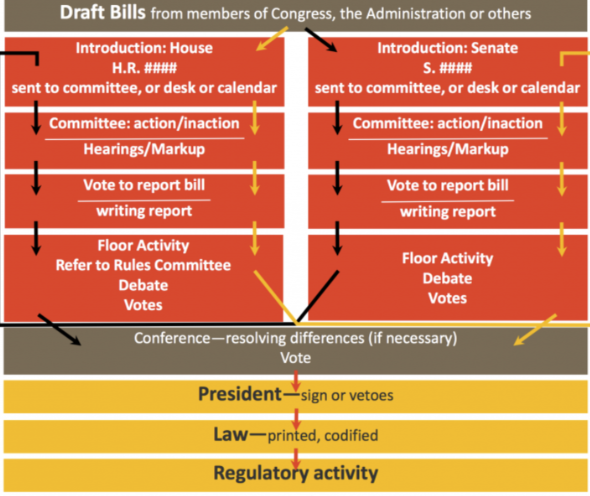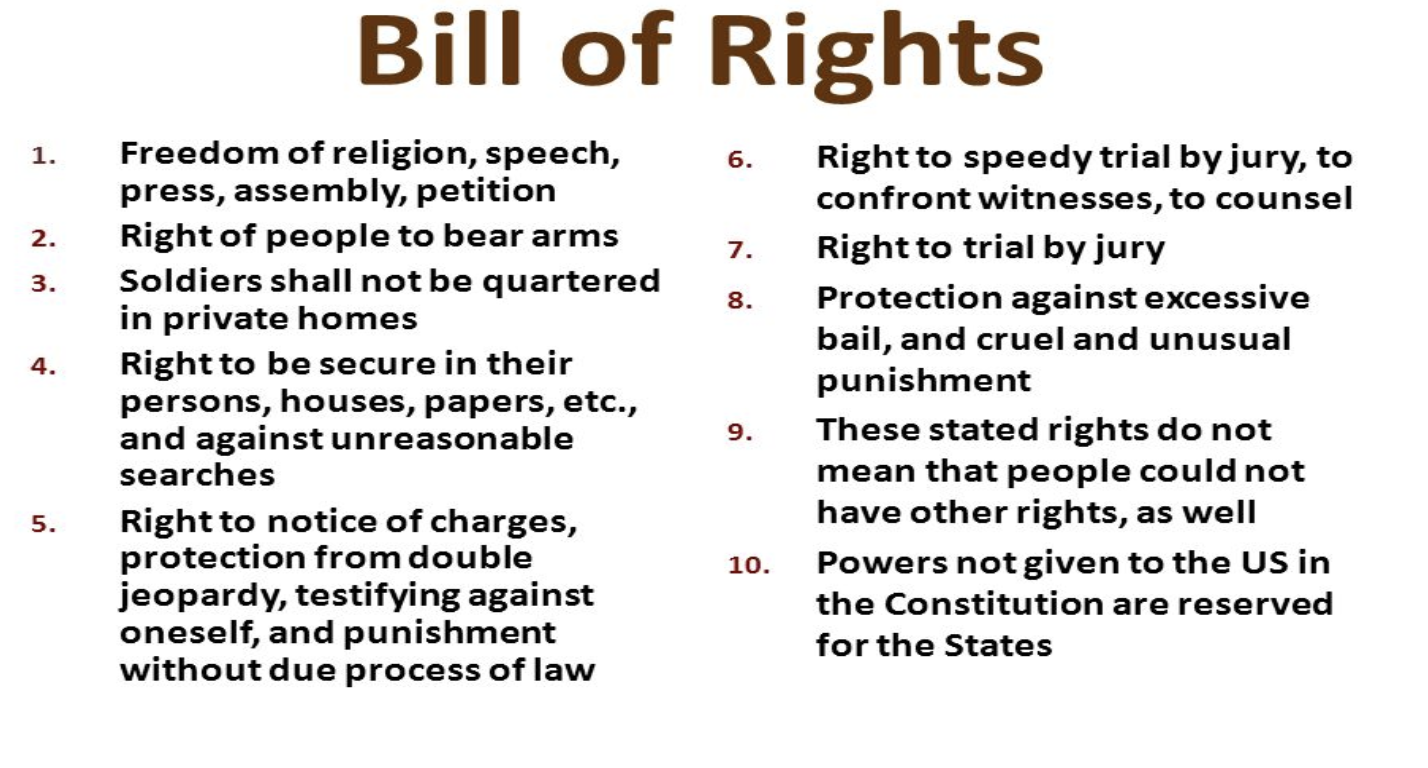US Government
1/44
Earn XP
Description and Tags
Name | Mastery | Learn | Test | Matching | Spaced |
|---|
No study sessions yet.
45 Terms
What are the 3 branches of government?
Legislative (makes laws), Executive (enforces laws), Judicial (interprets laws)
Congress
made up of the House of Representatives and the Senate + special agencies and offices that provide support services to Congress, part of the Legislative Branch
Legislative Branch
makes laws; made up of Congress (House of Reps. and Senate)
Roles:
drafting proposed laws
having the authority to declare war
confirming or rejecting presidential nomination for head of federal agencies, federal judges, and Supreme Court
House of Representatives
part of Congress (Legislative Branch)
has 435 representatives
depends on the population of an area
must have at least 1 representative per state
3 extra for the District of Columbia (DC)
representatives serve a 2-year term
must be at least 25 years old
must be a citizen for 7 years
House can propose tax laws
House can impeach present
Senate
part of Congress (Legislative branch)
100 members; 2 for every 50 state
senators serve a 6-year term
must be at least 30 years old
must have been a citizen for 9 years
Senate can approve Presidential appointments
Senate approves treaties from a foreign government
Senate tries President after impeachment
The Vice President is the President of the Senate, a tie-breaker during voting
General Powers of Congress
Propose and pass legislation (make laws)
Coin Money
Declare War
Raise an Army
Regulate Commerce (taxation)
establish Federal courts
establish rules of naturalization/immigration
Roles in the Executive Branch
made up of the President, Vice President, and the Cabinet + executive departments, independent agencies, and other boards, commissions, and committees
Executive Branch
enforce laws
made up of the President, Vice President, and the Cabinet
4-year term (can be eight in total if they’re reelected)
must be 35 years old
must be a resident for 14 years or must be a US citizen by birth
President
must be elected based on receiving the majority of electoral votes (at least 270)
Roles/Power
commander of some state’s military
leader of the federal government
Commander and Chief of the US Army
the president has the power to approve/veto laws
the president makes treaties with foreign governments
the president nominates the judges for the Supreme Court (judicial branch)
can grant pardons or retrieve
advises the Senate
Vice President
presides the president
Roles/Powers
supports the president
becomes president if the president is unable to fill their role
the main role is to stay alive to be able to fill the president’s role if necessary
presides (president) of the US Senate and breaks ties in Senate votes
does the stuff the president usually doesn’t want to do
The Cabinet
cabinet members = advisors to the president, each has their own focus that they can provide knowledge about to the president
includes the vice president, heads of executive departments (15 in total), and other high-ranking government officials
Cabinet members are elected by the President but are approved by the Senate
Electoral (College) Votes
270 votes out of 538 needed to win (majority of votes)
the majority takes all system —> for each state the majority of electoral votes from one side means all the electoral votes of that state go toward that side
Ex. if Massachusetts Democratic electoral votes win all the votes go to the Democratic candidate
no representation in states that always swing to one side
Electoral Votes Calculation:
435 Representatives
100 Senators
3 District of Columbia (D.C)
= 538 Electoral College Votes in total
*electors determined by the population, # of Senators + # of Congressional Representatives
Who Presides the President
1) President
2) Vice President
3) Speaker of the House
4) Elect new president
Judicial Branch
interprets laws
made up by the Supreme + Federal Court
serve life long term
9 representatives
uneven # so the odds always must go one way
most of our representatives are Republican right now; the Supreme Court is swayed
nominated by the President and approved by the Senate
The Head of the Supreme Court = Chief Justice
Judicial Branch Powers
can declare laws unconstitutional
can settles disputes involving the US
Chief Justice and Supreme Court presides over the impeachment trial of the president
Evaluates law by:
interpreting the meaning of the law
applying laws to individual cases
decided if laws violate the Constitution
Electoral College Pros
Prevents too many viable Presidential candidates from running--reinforces stable 2 party system
Ensures interests of all states are represented (particularly those of small, rural states)
Guarantees certainty to outcome--magnifies the difference between winner and loser in most cases
Electoral College Cons
The Electoral College is fundamentally undemocratic and ignores will of the majority
The original reason for the Electoral College is no longer relevant
The Electoral College gives too much power to swing states and allows the election to be decided by a small handful of states (which are mostly the same in every election)
Depresses voter turnout in non-swing states
Checks and Balances: Legislative and Executive
the president can veto congressional legislation
congress controls budget
congress approves presidential nominations
congress can pass laws with a 2/3 majority vote over the presidents’ veto
congress can impeach and/or remove them from office
(some examples)
Checks and Balances: Legislative and Judicial
the court can declare laws unconstitutional
the Senate confirms the presidents nominations for the judicial courts
congress can impeach judges and remove them
Checks and Balances: Executive and Judicial
the president nominates judges
the Supreme Court can declare presidential acts unconstitutional
Checks and Balances
the ability to respond to the actions of the other branches of government
prevent any one branch having too much power; tyranny
Democratic Party
Role of Gov.:Bigger, active government/Higher Taxes
Social Policy: Gov. should actively help the disadvantaged: social security/welfare/health care
Business: Gov. should regulate quality, emissions,practices, etc.
Abortion: pro-choice (right to abortion)
Environmental: protection oriented:entitlements like welfare,action, public education
Rights/Responsibility Emphasis: "Government should help those who can't help themselves"
Symbol: blue, donkey
Republican Party
Role of Gov.: smaller, less obtrusive government, Lower taxes, Government programs only when needed
Social Policy: Private charities to help the poor, "faith based initiatives", Importance of incentive/work programs
Business: Laissez faire (less government regulation)--market forces determine most efficient way of producing things
Abortion: pro-life/anti-abortion
Environmental: Responsible use of natural resources/exploitation of natural resources to help working people
Rights/Responsibility oriented: Emphasizes indiv. choice:
A)private/charter schools
B)medical plans
C)retirement money-private investment
Symbols: red, elephant
Pigeon Hold
To put aside or ignore a bill to not have to deal with it, so it gets forgotten about purposefully
A Mark-Up
refers to the meeting of a Committee held to review the text of a bill before reporting it out. Committee members offer and vote on proposed changes to the bill’s language, known as amendments. Most mark-ups end with a vote to send the new version of the bill to the floor for final approval
Pork-Barrel Legislation
Appropriations of public funds by Congress (or other legislative assemblies) for projects that do not serve the interests of any large portion of the country's citizenry but are nevertheless vigorously promoted by a small group of legislators because they will pump outside taxpayers' money and resources into the local districts these legislators represent.
Logrolling
A practice common in the U.S. Congress and in many other legislative assemblies in which two (or more) legislators agree for each to trade his vote on one bill he cares little about in exchange for the other's vote on a bill that is personally much more important to him
Political Lobbies:
Professional organizations/advocates (frequently lawyers) who argue for specific legislation
-involves advertising, fundraising, supporting political campaigns of candidates who support your policy
Redistricting and Gerrymandering
Drawing electoral lines that benefit a specific political Party in power
Filibuster
The use of obstructionist tactics, especially prolonged speechmaking, for the purpose of delaying legislative action
How A Bill Becomes A Law

swing-state
states that could go to either political parties side
impeachment
getting charged with a crime
Bill of Rights

Cloture
measure that can end a filibuster; if the bill is agreed upon by a 3/5 vote by the senators in favor to trial the bill
if the bill is accepted then it will be discussed and then another 3/5th vote will be taken to determine if it will be passed
Numbers of Amendments in Our Constitution
27 amendments
Massachusetts Senators
Elizabeth Warren and Ed Markey
Our Districts Congresswoman
Lori Trahan (3rd district)
Congressional term of service length
two years
Example of Cabinet positions
Secretary of State and Secretary of Defense
Chief Justice of the U.S Supreme Court
John Roberts
Massachusetts Governor
Maura Heeley
Current Indian Tribe in MA
Wampanoag
cracking
in terms of gerrymandering; Splitting the opposing party's voters into many different districts
packing
in terms of gerrymandering; packing as many voters as possible of an opposing party into one district